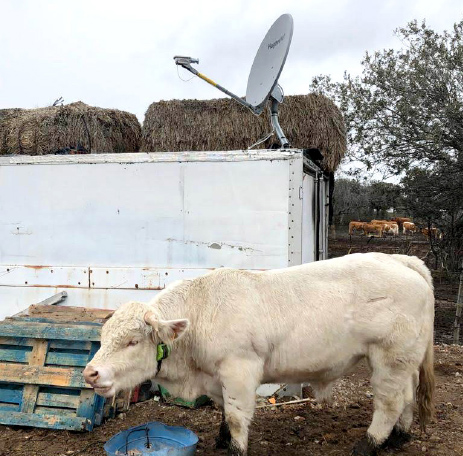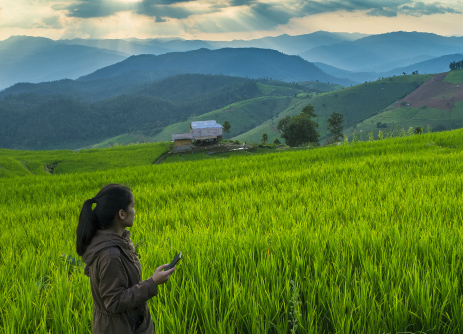For HISPASAT, innovation is key for developing new business models, and it is the stepping stone towards:
- Generating competitive sales.
- Being a launch pad for the use of new telecommunications technologies.
- Improving efficiency in work processes and communication.
At HISPASAT, innovation is approached from a transversal perspective, in which professionals from different areas of the company take part in multi-disciplinary teams on a project-by-project basis, putting their know-how on satellites, telecommunications networks and applications at the service of new projects.
Externally, HISPASAT collaborates closely with the main satellite manufacturers, ground equipment producers, telecommunications operators and benchmark research centres.
During 2019, HISPASAT has boosted innovation activities by creating an Innovation Management team in order to define, coordinate, prioritise and monitor innovation lines.
THE MAIN INNOVATION ACTIVITIES CARRIED OUT IN 2019 CAN BE GROUPED AS FOLLOWS:
VIDEO SOLUTIONS
HISPASAT continues to develop solutions that add value to its video offering. Thanks to their high capacity, ease of deployment and extensive coverage, satellites are still key for broadcasting high added value content such as 4K high resolution TV. Within Innovation, efforts are being made to enrich video on demand services by incorporating Push VoD via satellite, which means the end user can choose from a menu of audiovisual content that they can enjoy whenever they want without having to be connected to the network.
The Push VoD service is targeted at customers who do not have broadband Internet access. Also, it can be used in maritime and aerial environments and it can be offered alongside a linear TV package.
SECURITY AND EMERGENCIES
Satellites play a very important role in the security and emergencies arena thanks to their location and wide coverage. In order to consolidate HISPASAT’s position as a reference in service provision, the company has worked with land segment technology manufacturers to incorporate adapted access solutions. By doing so, a high-performance fast deployment antenna and antennae adapted to mobility environments with electro-mechanical targeting for security and emergencies have been incorporated.
Along the same lines, HISPASAT continues to participate in the UNICRINF Horizon 2020 project, in which satellite telecommunications infrastructure is employed in disaster situations.
MOBILITY
The Innovation department has worked on promoting initiatives to develop self-pointing flat antennae that allow for the roll-out of solutions for land mobility via satellite. Feasibility studies and demonstrations have been carried out with the main manufacturers, and an agreement has been reached to develop flat antennae for professional vehicles.
At the same time, work has continued to develop a low data rate terminal for mobility environments and the company has kept working on defining and implementing rail and maritime connectivity solutions, including added value services like content distribution using the Push VoD platform.
HISPASAT has continued to be strongly committed to developing satellite connectivity solutions for land, maritime and air transport.
CONNECTED CARS
Throughout 2019 the results of the national Sat2Car project were presented. HISPASAT participated in the project together with the PSA group and EGATEL, among others, heading up activities related to satellite communications infrastructure, contributing the necessary infrastructure for tests on both the space segment using satellites H30W-5 and H30W-6, and the land segment (hub located in the Canary Islands and remote terminal in Vigo).
The final demonstrator was carried out at the CTAG facilities in Vigo, where the final tests of both terrestrial and satellite connectivity were successfully carried out, validating the comprehensive system of services and mobile applications specifically designed for connected cars. The tests carried out using the satellite link referred to SW update applications, detecting errors in software, downloading instruction manuals, maps, instant messaging, etc.
5G
Satellites play a very important role in developing and rolling out the new 5G infrastructure, being the ideal allies for terrestrial networks. 5G is the network of networks and satellites can complement the roll-out of the technology, reducing investment costs and ensuring coverage across the entire territory.
During 2019, HISPASAT has continued to promote the presence of satellites in the 5G ecosystem environment, collaborating on and monitoring 3GPP (3rd Generation Partnership Project) progress in matters related to satellites thanks to the ESOA group of standards.
Smart Energy
Thanks to HISPASAT’s participation in the NRG5 project (H2020), a greater understanding of the problems associated with the operation and maintenance of Smart Energy networks has been reached. Numerous analyses and designs have been carried out for the development, deployment and management of communication infrastructures in the context of Smart Energy. Various use cases in which satellite connectivity, as a complement to the 5G ground infrastructure, can be applied to electricity and gas infrastructure assets, allowing for covering the full spectrum of communication needs in the supervision of predictive maintenance with the use of drones in energy generation and transport infrastructures.
Smart tourism
In 2019 network designs have been developed to connect “Smart Tourism Destinations (DTIs)”, where connectivity is provided to an area that is of great interest to tourists but lacks terrestrial communications infrastructure, such as the Puig Campana mountain in Finestrat (Alicante). This is the first mountain to have connectivity with Narrow Band IoT nodes that have WiFi connectivity for mobile devices, as well as a node with 4G coverage, and an app so that the 20,000 visitors per year feel safer, can receive help in an emergency, and get real time information on the weather. This “smart mountain” project is part of the strategy to provide satellite connectivity to a grey area to improve communications. HISPASAT’s goal is to develop smart solutions and to allow rural settings to have connectivity along the same lines as solutions that are more adapted to the Smart City environment.
Professional mobility
At the Barcelona Mobile World Congress in 2019, HISPASAT demonstrated that it is possible to combine terrestrial and satellite connections to guarantee permanent 5G connectivity between a medical ambulance and the accident and emergency services of a hospital. Through this connection, it was shown how emergency health workers could receive advice from specialists in a hospital using an audiovisual connection between the vehicle and the hospital, allowing for direct monitoring of the patient’s condition by the specialist, a critical intervention for the survival and subsequent recovery of the patient.
INTERNET OF THINGS (IoT)
Thanks to their extensive coverage, satellites are ideal for offering IoT services ubiquitously and independently of whether there are terrestrial networks.
The IoT has been a focus of innovation during 2019. HISPASAT worked on looking for and analysing access solutions adapted to the IoT (low transmission rate and low consumption), and various IoT application pilots have been carried out in the agri-food industry. Agreements have been reached with one of the main agro ERP (Enterprise Resource Planning) providers to offer added value services.
In this context, in 2019 two pilot projects got underway to promote digital transformation in the rural agri-food sector and to bridge the digital divide in the field through technologies like satellites and WiFi hotspots.
The first of these, developed alongside the company Digitanimal, a manufacturer of cattle localisation and monitoring systems, provided connectivity via satellite to a 400 hectare farm located on a mountain in Ávila through an antenna pointed at the HISPASAT fleet. This antenna can send the data received from the sensors on 130 cattle to the control centre.
The other pilot programme was located in a crop field at Florette, the packaged salads and vegetables company, where a satellite WiFi hotspot has been installed. This technology provides broadband connectivity so that the farmhands can manage the crops in real time from their mobile devices, without having to move to more remote areas with land-based connectivity.
CONNECTING THOSE WITH NO CONNECTION
HISPASAT contributes to bridging the digital divide. Every day the need for connectivity is greater, and satellites play a key role in rural areas.
In 2019 the company continued to develop and deploy solutions adapted to the rural environment, such as satellite WiFi hot-spots, which make it possible to offer fast, simple and inexpensive Internet access to those regions where deploying infrastructure is difficult. Work has also been done to analyse low cost integrated backhaul solutions for expanding mobile networks in rural environments.
INFRASTRUCTURE
From Innovation, work has been done on the search for new infrastructures that provide a competitive advantage in terms of costs and benefits for HISPASAT.
In this regard, various working groups are working with manufacturers and suppliers of HAP (High Altitude Platform) solutions, analysing the feasibility and the possibility of providing hybrid HAP – Satellite services. HAPs offer flexibility, new services like direct communications, from smartphones to 4G and 5G networks, as well as low latency, meaning that they could be the ideal complement to GEO satellites.
© Informe Anual Hispasat 2018
Paseo de la Castellana, 39 28046 Madrid Spain
+34 91 710 25 40







